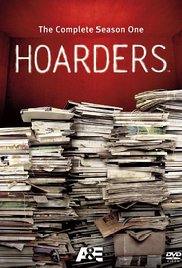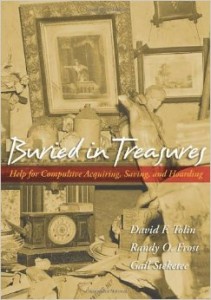This post is part of a series of guest posts on GPS by the graduate students in my Psychopathology course. As part of their work for the course, each student had to demonstrate mastery of the skill of “Educating the Public about Mental Health.” To that end, each student has to prepare two 1,000ish word posts on a particular class of mental disorders.
______________________________________________
More than Guilt Trips and Dump Trucks: Evidence-Based Treatment for Hoarding Disorder by Deah Abbott
 Between the A&E show Hoarders, Lifetime’s show Hoarders: Family Secrets, TLC’s show Hoarding: Buried Alive, various features on shows like The Oprah Winfrey Show and Dr. Phil, and even Kathy Griffin’s stand up, pop-culture has been saturated for several years with the images and stories of people who struggle with compulsive hoarding. While these not-so scholarly sources have widened name recognition and awareness that Hoarding Disorder exists, they have also miseducated the masses about the treatment and causes of the disorder. From watching these shows you might assume that this disorder has a quick fix: guilt trips and dump trucks. Here, for instance, you can see a woman confronted by her sister while cleaners throw items into a dump truck. Most of these shows have strict deadlines for clean-up; here you can see a woman comment that she doesn’t think her problem will be solved within the meager two day deadline. These shows are often only concerned about the emotional drama and the exciting clean reveal at the end. Sometimes they don’t even clean the whole house, but only clean the areas they plan to air in the episode. Even if the clean-up were completely thorough, this form of “treatment” for people with hoarding disorder can lead to feelings of betrayal and mistrust of those family members who insisted on “helping” and usually leads to relapse and increased resistance to seeking further help.
Between the A&E show Hoarders, Lifetime’s show Hoarders: Family Secrets, TLC’s show Hoarding: Buried Alive, various features on shows like The Oprah Winfrey Show and Dr. Phil, and even Kathy Griffin’s stand up, pop-culture has been saturated for several years with the images and stories of people who struggle with compulsive hoarding. While these not-so scholarly sources have widened name recognition and awareness that Hoarding Disorder exists, they have also miseducated the masses about the treatment and causes of the disorder. From watching these shows you might assume that this disorder has a quick fix: guilt trips and dump trucks. Here, for instance, you can see a woman confronted by her sister while cleaners throw items into a dump truck. Most of these shows have strict deadlines for clean-up; here you can see a woman comment that she doesn’t think her problem will be solved within the meager two day deadline. These shows are often only concerned about the emotional drama and the exciting clean reveal at the end. Sometimes they don’t even clean the whole house, but only clean the areas they plan to air in the episode. Even if the clean-up were completely thorough, this form of “treatment” for people with hoarding disorder can lead to feelings of betrayal and mistrust of those family members who insisted on “helping” and usually leads to relapse and increased resistance to seeking further help.
So, can hoarding disorder be “cured” with cinematic guilt trips, a couple of days cleaning up, and a row of dump trucks? The short answer: no. Hoarding disorder is caused by more than just a tendency towards being untidy. According to Dr. Randy Frost and Dr. Tamara Hartl, hoarding disorder is the result of deficits in information processing, issues with forming emotional attachments, behavioral avoidance, and problematic beliefs about the nature of possessions. Dr. Frost explains that people with hoarding disorder, among other things, categorize items in a complicated manner that eventually becomes too unruly to handle. Many also develop extremely strong emotional attachments to the objects they own. People with hoarding disorder experience heightened anxiety, sadness, indecisiveness, and distress when trying to assess which of their own possessions to keep and which to discard.
 So, what is the best treatment? The most validated and effective treatment is a type of cognitive behavioral therapy (CBT) that is specifically designed for hoarding disorder. This treatment usually consists of 26 weekly sessions at a therapist’s that range from 1 hour to 1.5 hours in length. At least once a month, the therapist would meet the client at his or her home for a 2 hour session. This version of CBT is quite lengthy, usually lasting between 7 and 11 months. The treatment is as multi-faceted as the disorder. Much of the treatment is focused on psycho-education: teaching the client about the disorder and what thought patterns are of concern and which ones are helpful. Treatment also involves teaching the client new ways to sort and organize things and problem solve. There is also a focus on cognitive restructuring, learning how to confront problematic thoughts and replacing them with more helpful thoughts. The treatment includes an element of controlled exposure therapy wherein the client is exposed to the distressing feelings associated with discarding their possessions, but this is not the primary focus of therapy. The client also practices throwing away or giving away their items and not acquiring new ones. During treatment, the client is usually directed through a workbook called Compulsive Hoarding and Acquiring while the therapist uses the related reference book. In addition to the resources above, Buried in Treasures: Help for Compulsive Acquiring, Saving, and Hoarding is an excellent book that is sometimes utilized in support groups or as a bibliotherapy for those struggling with hoarding disorder.
So, what is the best treatment? The most validated and effective treatment is a type of cognitive behavioral therapy (CBT) that is specifically designed for hoarding disorder. This treatment usually consists of 26 weekly sessions at a therapist’s that range from 1 hour to 1.5 hours in length. At least once a month, the therapist would meet the client at his or her home for a 2 hour session. This version of CBT is quite lengthy, usually lasting between 7 and 11 months. The treatment is as multi-faceted as the disorder. Much of the treatment is focused on psycho-education: teaching the client about the disorder and what thought patterns are of concern and which ones are helpful. Treatment also involves teaching the client new ways to sort and organize things and problem solve. There is also a focus on cognitive restructuring, learning how to confront problematic thoughts and replacing them with more helpful thoughts. The treatment includes an element of controlled exposure therapy wherein the client is exposed to the distressing feelings associated with discarding their possessions, but this is not the primary focus of therapy. The client also practices throwing away or giving away their items and not acquiring new ones. During treatment, the client is usually directed through a workbook called Compulsive Hoarding and Acquiring while the therapist uses the related reference book. In addition to the resources above, Buried in Treasures: Help for Compulsive Acquiring, Saving, and Hoarding is an excellent book that is sometimes utilized in support groups or as a bibliotherapy for those struggling with hoarding disorder.
Group sessions of this specialized cognitive behavioral therapy can also be effective, though not as effective as individual sessions. This may in part be because most researched therapy groups have a significantly reduced number of home visits. There is some evidence that new treatments are on the horizon. A new online-based therapy for hoarding disorder shows promise, but more research is needed.
Initial symptoms of hoarding disorder can start at a young age. 40% of adults with hoarding disorder report having symptoms of hoarding disorder before age 16. Hoarding disorder in children can start as young as young as three. However, because the efficacy for hoarding specific CBT for children has yet to be determined, more research is needed in this area to determine effective treatment.
Medication is not a stand-alone treatment for hoarding disorder. However, medication for commonly co-occurring issues such as anxiety or depression can be helpful during the course of treatment. Untreated increases in anxiety and depression may lead to increases in hoarding symptomatology and greater resistance to treatment.
The scientifically validated treatment for hoarding disorder could not be more different than the slap-dash commercialized TV-show method. Treating hoarding disorder takes time and care. For those wanting to peer into the world of hoarding without being enraged by the harmful practices of reality shows, Stuff: Compulsive Hoarding and the Meaning of Things is an interesting and compelling read.
